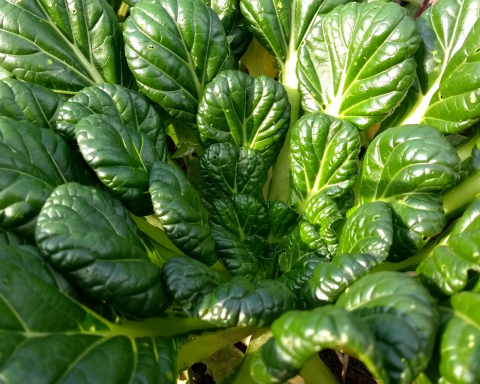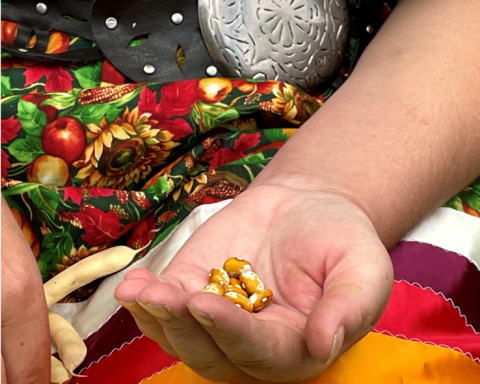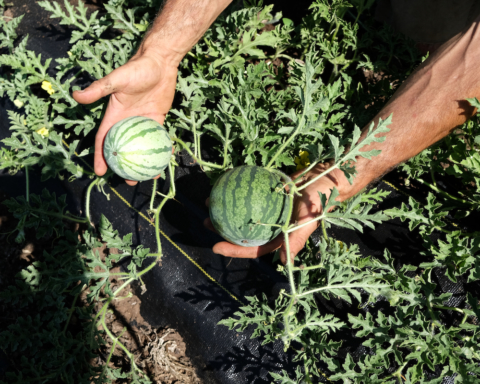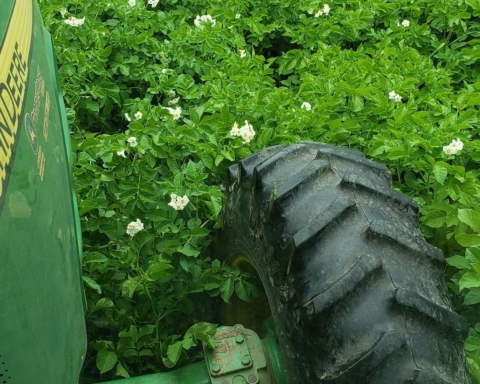Three case studies examine soil management practices in the face of climate change
By Rachel Penner, BC Agriculture & Food Climate Action Initiative
Improving soil health is one way producers can increase the resilience of their operations in the face of climate change. The BC Agriculture & Food Climate Action Initiative (CAI) has supported multiple projects, with funding from the provincial and federal governments, evaluating practices to maintain or improve soil health. Case studies in three regions of the province offer some practical takeaways for farmers looking to adapt to changes in climate.
Okanagan: Adding Compost and Reducing Irrigation
Climate change is expected to increase average temperatures and lengthen the growing season in BC’s Interior, enabling cherry producers to expand production northward and grow crops at higher elevations. However, expanding production may be limited by challenges with managing soil pathogens and by water availability.
A three-year research project focusing on cherry production in the Okanagan resulted in two key findings:
- adding compost to old and new orchards helped maintain soil health
- reducing post-harvest irrigation by 25% did not impact fruit yield or quality
Gayle Krahn, the horticulture manager at Coral Beach Farms, participated in the project. “It’s through these trials that growers gain the confidence needed to invest in mulches,” says Krahn. “As well, the results from the deficit irrigation studies gave us a good handle on how much water we need in our orchards. Climate change could affect our water supply, so we need to be mindful of our water usage while ensuring we can continue to grow healthy crops.”
Louise Nelson with the Biology department at UBC Okanagan led the three-year experiment. Researchers monitored the effects of compost and mulch applications, comparing results with controls in two new and one established orchard, and assessed the impacts of post-harvest deficit-irrigation.
The study, completed in 2018, revealed that adding compost to cherry orchards had the following impacts on the soil:
- increased soil organic matter, total carbon and nitrogen, other mineral nutrients and pH
- increased percentages of nitrogen, phosphorus and potassium in leaves after two years
- increased fruit firmness and stem pull
- tended to increase total nematode abundance in soil
- tended to decrease plant parasitic nematodes in plant roots and soil
- decreased colonization of roots by arbuscular mycorrhizal fungi
“I would definitely recommend that growers invest in compost as it helps build soil structure, reduce moisture loss and keep soils cool during summer heat,” says Krahn. “The result is increased root growth and a healthier tree, which equates to growing quality fruit.”
The study also found that a 25% reduction in post-harvest irrigation had no impact on fruit yield and quality, stem water potential, tree growth, or leaf mineral content, giving producers greater assurance that they can safely decrease water usage in their cherry orchards post-harvest.
Delta: Using and Maintaining Tile Drains
Climate projections indicate that winter rainfall will increase and extreme rainfall events will double in frequency by the 2050s in BC’s Fraser River delta. This increase in moisture could prevent farmers from getting onto waterlogged fields, either to plant or to harvest, and could also increase soil erosion, nutrient runoff, and damage to crops.
However, effective spacing and maintenance of tile drains can increase the ability of producers to work their fields.
A project in Delta, completed in July 2017, evaluated practices for improving on-farm drainage management as a way to adapt to wetter spring and fall conditions. The project, led by three researchers in the Faculty of Land & Food Systems at UBC in collaboration with the Delta Farmers’ Institute, the Delta Farmland & Wildlife Trust and local farmers, set up demonstration sites on two fields and monitored practices across a total of 30 fields in multiple locations.
The results of the two-year project indicated the following:
- Using tile drains in vegetable crop fields increased workable days by 8% and by 14% when pumps where also used. (The impact was negligible for blueberry fields.)
- Drain tiles spaced at 15 feet allowed soil to dry faster in the spring than drain tiles spaced at 30 feet.
- Cleaning tile drains resulted in 12 extra workable days per year at a cleaning cost of $10/additional workable day/acre.
Central Interior: Practising Management-intensive Grazing
Management-intensive grazing, a practice that involves planned grazing and rest periods for pastures, is a context-dependent practice that can vary from one rancher and pasture location to the next, making it difficult to test the impact it has on soil.
A four-year project in BC’s Central Interior, completed in spring 2017, compared grazing practices and used traditional soil sampling methods, plant community composition and remote sensing to measure soil carbon. Results confirmed that management-intensive grazing increased soil carbon, which has important implications for soil health.
“What got me interested in grazing-management practices was the enthusiasm of the ranching community,” says Lauchlan Fraser, a professor at Thompson Rivers University who led the project. “I wanted to see if some of the claims that were being made held up.”
The data showed that, for intensively managed pastures, total carbon was 28% greater and organic carbon was 13% greater when compared to extensively managed pastures. It is widely agreed that this stored carbon is linked to soil health, and a fact sheet for the study stated that: “Benefits associated with greater soil carbon include soil moisture retention, erosion control and species biodiversity.”
These outcomes were experienced by the producers who participated in the study. All the ranchers reported that they saw improved soil moisture retention, which would help them cope better in a drought year. They also thought the practice would work as a tool to control invasive species and improve plant and animal diversity, both important contributors to resilient grazing systems.
“It would be worthwhile to follow up with doing the research required to test how biodiversity and soil moisture are influenced,” says Fraser.
While carbon sequestration is primarily associated with climate change mitigation, the project’s final report found additional implications for climate change adaptation: “Flexibility of electric fencing, and actively managing cattle on a daily basis, was identified to be an adaptation strategy, since a rancher is able to adapt his or her practices based on conditions which vary from one year to the next,” says Fraser.
Project Funding and Detailed Reports
For all three of the projects, funding was provided by the Governments of Canada and British Columbia through the Canadian Agricultural Program as part of the Farm Adaptation Innovator Program delivered by CAI.
Complete project results and fact sheets can be found on the CAI website at:
Rachel Penner is the Communications Specialist for the BC Agriculture & Food Climate Action Initiative. She grew up on a grain farm in southwestern Manitoba, received her journalism diploma in Alberta and spent time as a writer and editor in Saskatchewan. She now resides in Victoria, BC, where she works and volunteers as a communications designer and strategist.
Feature photo: Farm field in Delta, BC. Photo credit: CAI – Emrys Miller










